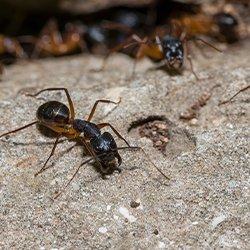As faithful residents of Western Massachusetts, we love to make the most of our outdoor time when the weather’s right. That’s why it can be so frustrating to deal with ants on our properties, at our picnics, our pool parties, our barbecues, our bathrooms, our kitchens, and everywhere in between. What’s really alarming, however, is when these ants appear in large numbers… and when some of them have wings.
Carpenter Ant Concerns
The fact that carpenter ants are a lot bigger than regular ants is not the main reason why they’re more concerning to have in your home. While carpenter ants measure half an inch to five-eighths of an inch long (quite a bit larger than other ants), this robust size is not what puts your home at risk. Their nesting habits are what you should really be concerned about.
Rather than creating mounds around your property like other ants, carpenter ants (aptly named) make their nests inside wood. They typically prefer to build these nests out of moistened or rotting wood, but they’ll also build in healthy wood as well. This includes your outdoor deck spaces and the inside of your home’s foundation. Their nesting habits create unsightly holes, cause damage to the wood, and even make your doors and windows tighten as their frames are damaged internally.
While they may not eat the wood in your home as termites do, they are still inside your house looking for their next easily accessible food source. This includes your stored foods, which puts you at risk for food contamination.
Noticing The Signs
Carpenter ants can do severe damage in your home over time, which occurs mostly because homeowners don’t recognize the signs of their activity. Spotting the signs early can help you save hundreds of dollars on potential damage, so be on the lookout for:
- Winged ants: carpenter ant swarmers fly from the nest in search of new locations to build new nests. They’ll shed their wings, which are a tell-tale sign of infestation.
- Piles of wood shaving: as they burrow into wood, the shavings will pile up on the ground or floor and should be very noticeable if you know what you’re looking for. However, these shavings are often pushed out in hidden places such as inside wall voids.
- Noises within the walls: as carpenter ants work, they’ll shave out layer after layer of wood, which can create a lot of damage over time. If you listen closely, you can hear the rustling noises within your walls, indicating a large population at work.
If you notice these signs of infestation, there is not much you can do to get rid of them. However, there are some things you can do to prevent them from winding up on your property in the first place.
Best Prevention Practices
These ants are large, resourceful, and some can fly. If they want to get into your western Massachusetts home, they will. However, you can limit the factors that attract them in just a few simple steps.
- Moisture control: managing moisture issues can help you avoid the wood rot that attracts carpenter ant infestations.
- Tree limb management: cutting back your tree limbs prevents carpenter ants from climbing the branches to the roof to begin nesting, which is one of their favorite ways to enter a home.
- Sealing cracks and crevices: using caulking around windowsills and the foundation, along with weather-stripping under doors, can prevent them from finding easy access points.
These steps will prove to be very effective in many cases. However, there are no guarantees when it comes to mother nature. The only guaranteed method of carpenter ant control comes from professional services: Contact American Pest Solutions at the first sign of carpenter ants to keep your home safe.

